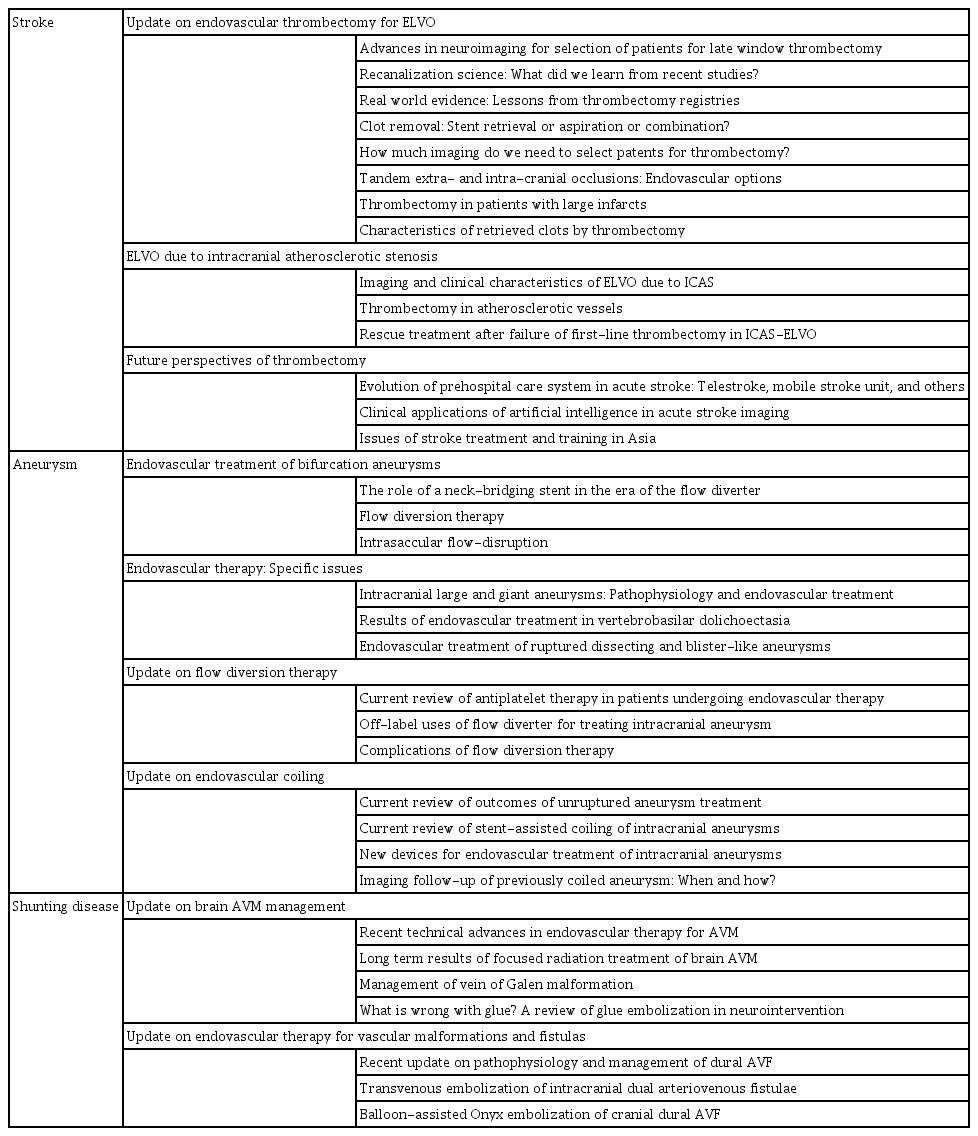Summary of the 14th Asian Australasian Federation of Interventional and Therapeutic Neuroradiology (AAFITN 2020): The Year 2020 with COVID-19, Another Chance for a New Leap
Article information
Everyone is having a tough time right now. The COVID-19 pandemic has changed all kinds of things in our everyday life. Fairly strict social distancing is performed in Korea, and most companies and people follow the directions faithfully. Under the social regulation, the ways of many businesses of the Korean Society of Interventional Neuroradiology (KSIN) have been also changed. One of the major changes was to make meetings and conferences “untact” by doing them online. We have just become familiar with the idea of being untact; however, there have been many trials and errors during the transition. Therefore, at this point, we would like to look back upon the trace of KSIN in 2020, which was made a kind of a special year by COVID-19.
THE 14TH AAFITN WAS HELD ONLINE FOR THE FIRST TIME
As already known, the 14th AAFITN was planned to be hosted in Seoul in 2020. The organizing committee of the AAFITN began in late 2018, and the AAFITN was originally supposed to be held in March 2020. The AAFITN was postponed to July 2020 due to the spread of COVID-19, although the preparation went well. Unfortunately, as the pandemic of COVID-19 got stronger and became a worldwide problem, the AAFITN was postponed again to October 2020. Moreover, it was exceptionally decided that the AAFITN would be held as an online symposium.
The decision was unavoidable, but it was so disappointing, as the interpersonal communication and lively discussions might be very limited in an online symposium. In fact, at that time, no one had enough experience with an online symposium, so the change was not welcomed. Thus, the organizing committee tried to make up for the disadvantages of the online symposium. The organizing committee particularly focused on the uninterrupted broadcasting of lectures and setting their archives on the web. Finally, as all of you may have experienced, the first online AAFITN was successfully finished.
Despite the COVID-19 pandemic, the 14th AAFITN was held on a considerable scale. A total of 445 participants from 26 countries (Afghanistan, Australia, Canada, China, France, Germany, Hong Kong, India, Indonesia, Japan, Kazakhstan, Korea, Malaysia, Mongolia, Pakistan, Philippines, Saudi Arabia, Singapore, South Africa, Spain, Sweden, Taiwan, Thailand, USA, United Kingdom, and Vietnam) participated in the conference. Notably, about half of the participants were from abroad, and this is an advantage of an online symposium. Eighty-four lectures in 6 regular sessions were designed, and a total of 73 lecturers were invited from all parts of the world. Also, as many as 250 abstracts from 24 countries were submitted, and then 166 were finally adopted through the review process.
A total of 31 sub-sessions were performed over 3 days. Among them, a wide range of neurointerventional treatments for various cerebrovascular diseases was covered in 34 plenary lectures (Table 1). By industry-sponsored symposiums, 26 lectures and workshops were also performed. On parallel symposiums, academic sessions with the “Korean Stroke Society” and the “Korean Society of Neuroradiology” were also performed. Moreover, as it was in all previous AAFITNs, the current status of neurointerventional treatment in participating countries was discussed and the “Women in INR” session was also performed.
The online symposium progressed smoothly. All real-time and prerecorded lectures were transmitted fluently without any difficulty through an awesome interface. Especially, e-poster pages were structurally dynamic enough to draw the audience’s attraction. Maximally, about 300 participants visited the symposium site on a day. In a plenary lecture session on the first day (Update on Endovascular Thrombectomy for Emergent Large Vessel Occlusion), surprisingly, 187 audiences were online at the same time.
UNTACT, BUT IN MORE CONTACT
The experience of the successful online AAFITN was applied to the Annual Conference of KSIN 2020 in the winter. The Annual Conference of KSIN was held online in December 2020 and had a total of 18 oral presentations and 5 lectures. Despite its online process, the conference was outstanding in that speakers and audiences could discuss their ideas in real-time. The Monthly Case Conference of KSIN could not be held in January 2020 due to COVID-19. However, it was constantly held from May 2020 as an online conference. KSIN members easily adapted to the online process, so about 140 members participated in the conference in July. As the Monthly Case Conference was essentially based on the active communication between members, it seemed so meaningful to continue the online conference all through the year. The Spring Symposium of KSIN was inevitably postponed, then held together online with the Summer Intensive Course in August. However, even under the worst situation of COVID-19 in Korea at that time, it ended in a big success with a total of 170 participants. Also, several council meetings were held online proficiently.
In the year 2020, KSIN showed itself in a completely new way. It is afraid that the “new way” will now become the “new normal”. However, we showed tremendous potential even under the COVID-19 pandemic in 2020, and we will be able to get over COVID-19 and leap forward.
Notes
Fund
None.
Ethics Statement
This study waived approval of the institutional ethics committee.
Conflicts of Interest
JB has been the Assistant Editor of the Neurointervention since 2019. No potential conflict of interest relevant to this article was reported.

